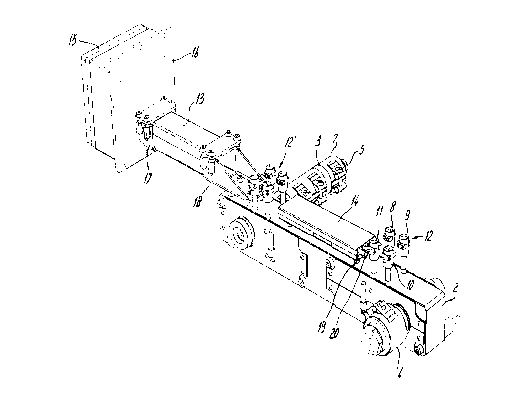Une partie des informations de ce site Web a été fournie par des sources externes. Le gouvernement du Canada n'assume aucune responsabilité concernant la précision, l'actualité ou la fiabilité des informations fournies par les sources externes. Les utilisateurs qui désirent employer cette information devraient consulter directement la source des informations. Le contenu fourni par les sources externes n'est pas assujetti aux exigences sur les langues officielles, la protection des renseignements personnels et l'accessibilité.
L'apparition de différences dans le texte et l'image des Revendications et de l'Abrégé dépend du moment auquel le document est publié. Les textes des Revendications et de l'Abrégé sont affichés :
| (12) Demande de brevet: | (11) CA 2260515 |
|---|---|
| (54) Titre français: | CONDUIT ELECTRIQUE MODULAIRE |
| (54) Titre anglais: | MODULAR CABLE GUIDE SYSTEM |
| Statut: | Réputée abandonnée et au-delà du délai pour le rétablissement - en attente de la réponse à l’avis de communication rejetée |
| (51) Classification internationale des brevets (CIB): |
|
|---|---|
| (72) Inventeurs : |
|
| (73) Titulaires : |
|
| (71) Demandeurs : |
|
| (74) Agent: | MCCARTHY TETRAULT LLP |
| (74) Co-agent: | |
| (45) Délivré: | |
| (22) Date de dépôt: | 1999-01-28 |
| (41) Mise à la disponibilité du public: | 1999-07-28 |
| Requête d'examen: | 2003-12-29 |
| Licence disponible: | S.O. |
| Cédé au domaine public: | S.O. |
| (25) Langue des documents déposés: | Anglais |
| Traité de coopération en matière de brevets (PCT): | Non |
|---|
| (30) Données de priorité de la demande: | ||||||
|---|---|---|---|---|---|---|
|
The invention relates to a modular cable guide system for use in an
injection moulding apparatus comprising
- at least one first cable guide conduit,
- at least one connector having a sleeve for fitting around a first
end of the first cable guide conduit, clamping means for tightening the
sleeve around the first cable guide conduit for forming a clamping
connection with the conduit and a coupling member for connecting the
connector to a machine part or to another cable guide conduit, and
- a second cable guide conduit having a number of regularly spaced
connecting holes for receiving coupling elements for connecting the
second guide conduit to the machine part.
The system according to the invention can be easily installed and
can be made to the right size and placed into the right configurations
upon installation.
Note : Les revendications sont présentées dans la langue officielle dans laquelle elles ont été soumises.
Note : Les descriptions sont présentées dans la langue officielle dans laquelle elles ont été soumises.

2024-08-01 : Dans le cadre de la transition vers les Brevets de nouvelle génération (BNG), la base de données sur les brevets canadiens (BDBC) contient désormais un Historique d'événement plus détaillé, qui reproduit le Journal des événements de notre nouvelle solution interne.
Veuillez noter que les événements débutant par « Inactive : » se réfèrent à des événements qui ne sont plus utilisés dans notre nouvelle solution interne.
Pour une meilleure compréhension de l'état de la demande ou brevet qui figure sur cette page, la rubrique Mise en garde , et les descriptions de Brevet , Historique d'événement , Taxes périodiques et Historique des paiements devraient être consultées.
| Description | Date |
|---|---|
| Demande non rétablie avant l'échéance | 2008-01-28 |
| Le délai pour l'annulation est expiré | 2008-01-28 |
| Réputée abandonnée - omission de répondre à un avis sur les taxes pour le maintien en état | 2007-01-29 |
| Lettre envoyée | 2004-01-20 |
| Requête d'examen reçue | 2003-12-29 |
| Exigences pour une requête d'examen - jugée conforme | 2003-12-29 |
| Toutes les exigences pour l'examen - jugée conforme | 2003-12-29 |
| Inactive : Page couverture publiée | 1999-08-02 |
| Demande publiée (accessible au public) | 1999-07-28 |
| Symbole de classement modifié | 1999-03-24 |
| Inactive : CIB en 1re position | 1999-03-24 |
| Inactive : CIB attribuée | 1999-03-24 |
| Inactive : CIB attribuée | 1999-03-24 |
| Inactive : CIB attribuée | 1999-03-23 |
| Inactive : Certificat de dépôt - Sans RE (Anglais) | 1999-03-03 |
| Exigences de dépôt - jugé conforme | 1999-03-03 |
| Demande reçue - nationale ordinaire | 1999-03-03 |
| Date d'abandonnement | Raison | Date de rétablissement |
|---|---|---|
| 2007-01-29 |
Le dernier paiement a été reçu le 2006-01-19
Avis : Si le paiement en totalité n'a pas été reçu au plus tard à la date indiquée, une taxe supplémentaire peut être imposée, soit une des taxes suivantes :
Veuillez vous référer à la page web des taxes sur les brevets de l'OPIC pour voir tous les montants actuels des taxes.
| Type de taxes | Anniversaire | Échéance | Date payée |
|---|---|---|---|
| Taxe pour le dépôt - générale | 1999-01-28 | ||
| Enregistrement d'un document | 1999-01-28 | ||
| TM (demande, 2e anniv.) - générale | 02 | 2001-01-29 | 2000-12-19 |
| TM (demande, 3e anniv.) - générale | 03 | 2002-01-28 | 2001-11-27 |
| TM (demande, 4e anniv.) - générale | 04 | 2003-01-28 | 2003-01-07 |
| Requête d'examen - générale | 2003-12-29 | ||
| TM (demande, 5e anniv.) - générale | 05 | 2004-01-28 | 2004-01-23 |
| TM (demande, 6e anniv.) - générale | 06 | 2005-01-28 | 2005-01-25 |
| TM (demande, 7e anniv.) - générale | 07 | 2006-01-30 | 2006-01-19 |
Les titulaires actuels et antérieures au dossier sont affichés en ordre alphabétique.
| Titulaires actuels au dossier |
|---|
| DYNISCO HOTRUNNERS B.V. |
| Titulaires antérieures au dossier |
|---|
| FRANCISCUS ANTONIUS JOSEF VAN BOEKEL |